 Playing (Less) Hurt
Playing (Less) Hurt
by Janet Horvath
Making music at any level is a powerful gift. While musicians have endless resources for learning the basics of their instruments and the theory of music, few books have explored the other subtleties and complexities that musicians face in their quest to play with ease and skill. The demands of solitary practice, hectic rehearsal schedules, challenging repertoire, performance pressures, awkward postures, and other physical strains have left a trail of injured, hearing-impaired, and frustrated musicians who have had few resources to guide them. Playing Less Hurt addresses this need with specific tools to avoid and alleviate injury. Impressively researched, the book is invaluable not only to musicians, but also to the coaches and medical professionals who work with them. Everyone from dentists to orthopedists, audiologists to neurologists, massage therapists and trainers will benefit from Janet Horvath’s coherent account of the physiology and psyche of a practicing musician. Writing with knowledge, sympathetic insight, humor, and aplomb, Horvath has created an essential resource for all musicians who want to play better and feel better.
 Stormy Applause
Stormy Applause
by Rostislav Dubinsky
Though written remarkably well and full of brave, defiant flashes of wit and humor, this is a sad and haunting book. Dubinsky was the founder and for 30 years the first violinist of the Borodin String Quartet, one of the supreme ensembles of its kind. Here he describes a musician’s life under a totalitarian regime: the soul-destroying restrictions and constant dangers, exacerbated by a pervasive anti-Semitism–officially illegal but actively encouraged and ruthlessly practiced by the authorities. The quartet’s original players were all Jews, though the cellist was a half-Jew who passed as Russian; the second violinist and violist were eventually replaced by Russians. Dubinsky was the “artistic director” in charge of rehearsals and musical decisions, but the quartet’s activities, including the members’ personal interrelationships, were completely dominated by politics. And indeed so is the narrative: Dubinsky only rarely talks about music, though always movingly and with insight, and never explains how the group attained its greatness.Certain scenes stand out: Stalin’s and Prokofiev’s deaths on the same day; vignettes of Russia’s greatest musicians, such as Shostakovich (whose quartets they played), Oistrakh, Richter, and Rostropovich; the group’s tours abroad, affording the first, overwhelmingly tempting glimpse of freedom; an anti-Russian demonstration in Cincinnati, defused when Dubinsky confronted the crowd; and the cellist’s near-fatal automobile accident in California. Ever present is the paralyzing fear of the mercenary, soulless Russian bureaucracy.
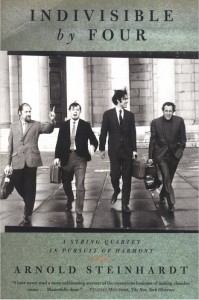 Indivisible by Four: A String Quartet in Pursuit of Harmony
Indivisible by Four: A String Quartet in Pursuit of Harmony
by Arnold Steinhardt
There are few good books written from inside a notable string quartet, and Steinhardt’s effort is a charming one. Having been together for 35 years, the Guarneri quartet, with John Dalley, Michael Tree, David Soyer and Steinhardt as first violin, is the oldest American group to have preserved the same membership. With self-effacing modesty (he is the first to insist that the first violin is not necessarily the leader of the group, though he may play a prominent role), Steinhardt describes both his own career and that of the group. He could have been a soloist or a successful orchestral musician, like most chamber players, but chose otherwise. The reasons he gives — the unwillingness to be regimented, the need for companionship on the road, the closeness to the music– are cogent ones, but a chamber group with permanent membership is an extraordinary organism all the same. Steinhardt skillfully describes the tensions, the long-running jokes, the arguments, the determinedly separate vacations–and the ecstasy when all the skills and long hours of practice come together in performances that strike to the heart of some of the most intimate music ever composed. Steinhardt’s book gives an excellent sense of the dynamics that have kept it going.
 The Art of Quartet Playing: The Guarneri Quartet
The Art of Quartet Playing: The Guarneri Quartet
by David Blum
These intelligent conversations will be greeted enthusiastically not only by string players and serious musicians but also by advanced listeners. A musicologist and conductor, Blum knows from experience what crucial questions to ask about the medium and its practice. The members of the Guarneri Quartet discuss their backgrounds, training, cooperative efforts, problems with specific repertoire, and reactions to composers and conductors, as well as such detailed matters as bowing, intonation, vibrato, pizzicato, dynamics and the use of the left hand. Enhanced by hundreds of music examples and a detailed analysis of Beethoven’s Opus 131, this is arguably the best book on the subject and one of the most important books on music issued in recent years. Performing Arts Book Club selection.
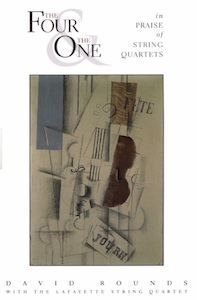 The Four and the One: In Praise of String Quartets
The Four and the One: In Praise of String Quartets
by David Rounds
Why have so many great composers reserved some of their most profound, personal music for their string quartets? This question has always fascinated musicians and chamber music lovers; in this book, David Rounds–a teacher, writer, chamber singer, and lifelong quartet addict–suggests an explanation: the instrumental combination resembles human voices, and socially the group resembles a family or a gathering of friends carrying on a conversation. Rounds remarks that the use of the same phrase to denote the musical form and the team of players indicates that a quartet performance is created by the participants’ interaction as much as by the written notes. The author’s premise, reflected in his title, is that in a quartet, four players and four instruments have to become one unit; to demonstrate the arduous process this requires, he enlisted the collaboration of the Lafayette Quartet, an all-women group in residence at the University of Victoria School of Music in Canada. Attending their rehearsals offered him, and the reader, a unique opportunity to follow their discussions and witness the emergence of an interpretation. The players also talked with Rounds about their personal and professional lives, speaking very frankly and with great intelligence, thoughtfulness, and conviction; though winningly spontaneous, these conversations could have used a little editorial polish. The book begins with an introduction to the development of chamber music and ends with a guide to the quartet repertoire.
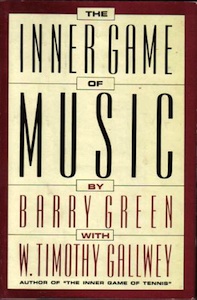 The Inner Game of Music
The Inner Game of Music
by Barry Green
By the best-selling co-author of Inner Tennis, here’s a book designed to help musicians overcome obstacles, help improve concentration, and reduce nervousness, allowing them to reach new levels of performing excellence and musical artistry.
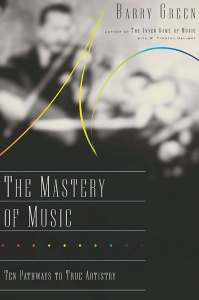 The Mastery of Music
The Mastery of Music
by Barry Green
This follow-up to The Inner Game of Music, which sought to teach musicians how to overcome mental barriers to inspired playing, bassist Green defines ten qualities that offer a “pathway to true artistry”: communication, courage, discipline, fun, passion, tolerance, concentration, confidence, ego/humility and creativity. “When you develop these qualities to a high level,” he says, “you have achieved mastery not only of your instrument and your concentration, but of who you are and how you present yourself to others.” Each “path” receives its own chapter of inspirational anecdotes and advice, and each is exemplified by a certain instrument or type of musician. For example, French horn and percussion, instruments that “just get one chance” and have “nowhere to hide,” illustrate the importance of courage; violas, who sit literally and musically between violins and cellos, represent tolerance; and duos, chamber groups and conductors symbolize the value of communication. Dozens of respected musicians, from Leonard Bernstein to members of the Harlem Boys Choir, share anecdotes about coping with stress, prioritizing, self-acceptance, preparation, concentration, focus and other life-skills. Along with general, inspirational advice for living and playing well, the book also makes valuable specific recommendations (e.g., the benefits of practicing slowly, establishing personal boundaries, visualization exercises, etc.). While the book’s gimmick may seem overworked at first, the author is so knowledgeable and sincere that his volume should appeal to musicians and music lovers of all stripes.
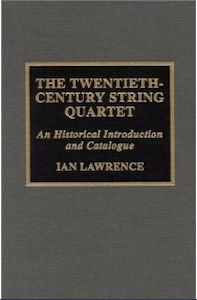 The Twentieth Century String Quartet
The Twentieth Century String Quartet
by Ian Lawrence
Comprehensive database of original works written for the standard string quartet during the twentieth century. The sources of information include publishers’ list, music reference materials, data from national music information centers, programmes, composers’ correspondence and other publicity materials. Lawrence lists countries that have produced string quartets throughout the century, as well as the context of a composer’s string-quartet output within the wider range of his/her work.
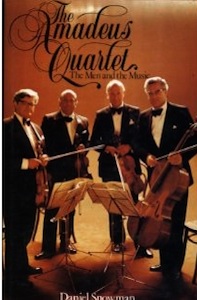 The Amadeus Quartet: The Men and the Music
The Amadeus Quartet: The Men and the Music
by David Snowman
This book tells the story of the Amadeus quartet, one of the most celebrated quartets of the 20th century. Because of their Jewish origin, violinists Norbert Brainin, Siegmund Nissel and Peter Schidlof (later violist) were driven out of Vienna after Hitler’s Anschluss of 1938. Brainin and Schidlof met in a British internment camp on the Isle of Man; many Jewish refugees had the misfortune of being confined by the British as “enemy aliens” upon seeking refuge in the UK. Brainin was released after a few months, but Schidlof remained in the camp, where he met Nissel. Finally Schidlof and Nissel were released, and the three of them were able to study with violin pedagogue Max Rostal, who taught them free of charge. It was through Rostal that they met cellist Martin Lovett, and in 1947 they formed the Brainin Quartet, which was renamed the Amadeus Quartet in 1948.The group gave its first performance as the Amadeus Quartet at the Wigmore Hall in London on 10 January 1948, underwritten by Imogen Holst.[1] Touring extensively, the Amadeus performed throughout Europe, Canada, the United States, Japan, and South America. Noted for its smooth, sophisticated style, its seamless ensemble playing, and its sensitive interpretation, the quartet made some 200 recordings.
 Married to the Amadeus: Life with a String Quartet
Married to the Amadeus: Life with a String Quartet
by Muriel Nissel
The Amadeus Quartet, which was active from 1948 until 1987 when its viola player Peter Schidlof died, is probably the most famous and distinguished string quartet of the 20th century. It played to a wide variety of audiences on innumerable occasions in all the major countries of the world, and produced a galaxy of recordings, many of which are still available. Muriel Nissel is the wife of Siegmund Nissel, the second violinist. Her book tells the extraordinary and moving story of the Quartet, with its many triumphs and its periodic setbacks and traumas, from the inside for the 40 years from its inception during the time after the Second World War up to the 1980s. She reveals how it molded the lives of the four players and their wives and families in unexpected ways, and how they all became inextricably involved in this unique joint enterprise.
 Con Brio: Four Russians Called the Budapest String Quartet
Con Brio: Four Russians Called the Budapest String Quartet
by Nat Brandt
A relaxed and engaging portrait of the incomparable chamber- music ensemble (1917-67) and its four most important principals, gracefully interwoven into a history of string-quartet playing in America. Brandt (The Congressman Who Got Away with Murder, 1991, etc.) was connected to the famed Budapest String Quartet during its headiest days: His father-in-law was the violist Boris Kroyt. Brandt’s affection for the men who shaped the group’s intimately communicative style (Joseph Roisman, first violin; Alexander (“Sasha”) Schneider, second violin; Kroyt; and Mischa Schneider, cello) never constrains his acute observations on the often difficult temperaments of four virtuosi who sublimated their own egos to achieve previously unattained artistic unity. Russian and Polish Jews, Roisman and company fled Hitler’s Europe for an uncertain future in America, where chamber music was among the last forms of serious music-making to be accepted. Extraordinary talent prevailed, however, and the Budapest became quartet-in-residence at the Library of Congress, giving an annual series of sold-out (and widely broadcast) recitals using Stradivarius instruments donated to the Library by a wealthy patroness. Among other fascinating sidelights, Brandt illuminates the democratic decision-making procedures the group employed to achieve a concert of musical vision: Contested points of interpretation were put to a vote, with any tie broken by “the composer’s vote” (cast by the instrumentalist whose predecessor had, with respect to the particular piece in question, won a match-stick drawing and whose initials had been noted on the first page of the score). This neatly written volume appears following Sony’s CD rerelease of the early Beethoven quartets recorded in 1951-52 by the same personnel (with the exception of Jac Gorodetsky for Sasha Schneider). Reading the book while listening to the recording reinforces the impression of the Budapest’s unanimity of cultural background and creative idealism. As the world that shaped this paragon fades, the legacy remains, thanks to modern technology and this sympathetic record. (Valuable discography and 26 halftones)
 What Every Violinist Needs to Know about the Body
What Every Violinist Needs to Know about the Body
by Jennifer Johnson
What Every Violinist Needs to Know about the Body is a comprehensive volume on using Body Mapping technique to help violinists prevent injury and develop the physical freedom and sensitivity needed for technical mastery. Beginning with the fundamental concepts of how and why musicians move, this book presents a detailed explanation of Body Mapping accompanied by numerous illustrations. Especially helpful is Chapter 8, devoted to common mis-mappings and myths in violin playing. This chapter exposes more than 50 misconceptions and provides helpful remedies.
Other recommended “hard to find” works:
String Quartet Playing
by Irving Fink
The Rise of the String Quartet
by Phillip Olleson
The Lost String Quartet
by N.M. Bodecker (children’s book)
Art of String Quartet Playing
by Herter M. Norton
The Juilliard String Quartet
by Harriet Gray


